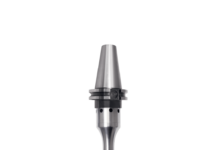Collaboration with Automation
Mobile robot colleagues on wheels increase productivity and worker safety at Scott Fetzer Electrical Group
A mobile fleet of Universal Robots will now receive daily work orders to solve ever-changing tasks with high mix-low volume electronics manufacturer Scott Fetzer Electrical Group (SFEG) in Tennessee. The collaborative robots have optimized production by 20 percent, taking over monotonous and potentially hazardous tasks from employees now reallocated to more rewarding jobs.
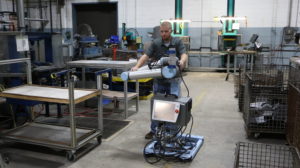 When the first UR5 robot arrived at Scott Fetzer Electrical Group (SFEG), it was quickly named “Waldo”, inspired by the popular “Where’s Waldo” books featuring a friendly fellow that keeps appearing in new places amongst crowds of people.
When the first UR5 robot arrived at Scott Fetzer Electrical Group (SFEG), it was quickly named “Waldo”, inspired by the popular “Where’s Waldo” books featuring a friendly fellow that keeps appearing in new places amongst crowds of people.
“One day Waldo would be bending sheet metal, the next day he would be performing pick and place tasks, and the third day we would take him to Manufacturing Day at the local high school,” says Matthew Bush, Director of Operations at SFEG that manufactures a wide range of electrical motors and components.
The fact that the Universal Robot are re-deployable and can operate with no safety guarding right next to humans is a radical break away from traditional industrial robot that usually stay hardwired behind safety guarding, fenced off from people. The UR robots are a new type of robot classified as collaborative due to their interactive design that makes it easy to set them up for a new task as well as their built-in safety system that enables the robot arm to automatically stop operating if it encounters objects or people in its route.
Traditional robots a challenge
Matthew Bush came across this new automation solution as he was looking for ways to make SFEG more competitive on the global scale, while taking more advantage of existing machinery.
“One of our biggest challenges is we’re a high mix-low volume producer, most of our lines don’t run all the time, so trying to find a way to put robots on the line in the traditional 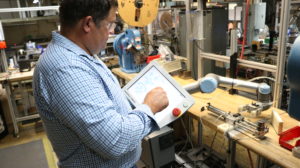 sense was a very big challenge,” says Bush, elaborating on his goal:
sense was a very big challenge,” says Bush, elaborating on his goal:
“We wanted to build a mobile, flexible robot force. The only way we would accomplish this was with a collaborative robot. We only saw a couple of offerings and the UR robot was the only robot that we thought could do the job. It’s got the speed and precision of a standard industrial robot with the ability to move around and work next to humans.”
SFEG placed the UR robots on pedestals with wheels and is now building the fleet of mobile UR robots deployed throughout the sheet metal department, integrating them in the entire production cycle from cutting the initial blank on the blanking press to forming, folding and final assembly of the electrical components. Additional robots are planned to help tend the turret presses and press brakes.
The UR robot as a pace setter
“Before we had the Universal Robots on our transformer line, we averaged about 10 parts per person per hour, that’s up to 12 parts per person per hour now,” explains Rob Goldiez, general manager at SFEG, “so about a 20% increase having a pace setter with the Universal Robots working hand in hand with our people.”
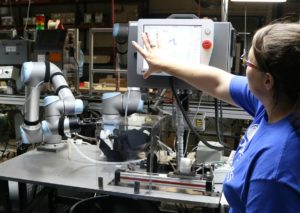 The UR robots working the motor field line are a UR5 and a UR10 robot named after their payload in kilos. The UR5 is placed at the end of the line right next to an employee that hands the robot a motor field part. The UR5 picks up the part, puts it in a holder, picks up a wire cutter to trim the wires, and then places the part for the UR10 robot to pick up and place on a conveyor for final assembly.
The UR robots working the motor field line are a UR5 and a UR10 robot named after their payload in kilos. The UR5 is placed at the end of the line right next to an employee that hands the robot a motor field part. The UR5 picks up the part, puts it in a holder, picks up a wire cutter to trim the wires, and then places the part for the UR10 robot to pick up and place on a conveyor for final assembly.
“We can interlock multiple robots together and read through Modbus the TCP connections and robot status. We can also pass information along to other software packages, and collect data. It opens up a lot of doors to do a lot of things we’re just now beginning to look at,” says Principal Engineer at SFEG, Jamie Cook.
Saved by “Thelma and Louise”
The wire cutting UR5 working in tandem with the UR10 has been embraced by the staff that named the new robotic team “Thelma and Louise”. According to Line Lead at SFEG, Sebrina Thompson, the naming arose when personnel first thought the robots were driving them off a cliff.
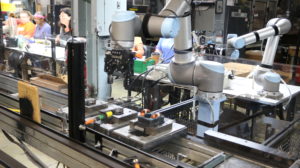 “When the robots first came out on the floor, employees were very anxious as they thought they would be replaced. But the robots handle a lot of tedious tasks for us now, enabling us to focus on more challenging jobs,” says the Line Lead, who also enjoys operating the UR robots.
“When the robots first came out on the floor, employees were very anxious as they thought they would be replaced. But the robots handle a lot of tedious tasks for us now, enabling us to focus on more challenging jobs,” says the Line Lead, who also enjoys operating the UR robots.
“I was surprised how simple it was. If you can work a smart phone, you can pretty much work these robots.”
Increasing Interest
The UR robots at SFEG were purchased through distributor Cross Automation covering the South Eastern part of the U.S. where Sales Engineers Karl Bentz is experiencing an increased demand for the collaborative robots.
“We’re seeing a lot of interest from tier one & two automotive suppliers with applications that replace some of the ergonomically unfavorable tasks performed by employees. The medical device industry here is also starting to use this new type of robots for tasks such as laser marking and assembly. As was the case at SFEG, once we sell one UR robot, the customer starts realizing what other tasks they could automate.”
About Scott Fetzer Electrical Group
SFEG combines expertise in transformers, power supplies, motion controls and drive systems with a U.S. based manufacturing footprint to create a platform of new product development. For more information, visit www.sfeg.com
About Universal Robots
Universal Robots’ product portfolio includes the UR3, UR5 and UR10 robot arms named after their payloads in kilos. Innovative force-sensing technology makes the robots stop operating when encountering an employee, eliminating the need for safety guarding in most scenarios where prior risk assessment deems the robot safe to operate in proximity to humans. For more information, visit www.universal-robots.com

